A culture of experimentation is a company mindset and way of working where employees actively seek out and experiment with new opportunities for innovation.
Employees recognize that remaining stuck in their ways exposes the company to disruptions caused by new technologies, changing customer demands, and new market players. They understand that adapting to change is essential to stay relevant.
We’ve been working with innovation managers for 10+ years and have seen many companies struggle to foster cultures of experimentation. We are sharing this guide to share some of the best practices we've used over the years, including how we reliably win leadership support and spark engagement from frontline employees, as well as mistakes to avoid.
We'll also review how we helped DHL establish a culture of experimentation in less than four weeks.
Finally, we discuss how our platform, InnovationCast, supports these best practices. Companies commonly struggle to implement a culture of experimentation and manage experiments at scale without dedicated innovation management software.
With InnovationCast, companies like DHL, ING, Visa, and Novo Nordisk have built cultures of experimentation — driving 80%+ employee participation in under four weeks.
Book a demo with our team to see how we can do the same for you.
Step 1: Secure Financial Buy-In From Top Management
Establishing an experimentation mindset throughout the organization starts with top management's buy-in.
If top management doesn’t understand the value of company-wide experimentation and is unwilling to provide financial and operational support, innovation managers won’t have the resources to build a culture of experimentation, let alone generate any business growth.
We recommend using Metered Funding when approaching top management for resources required to validate ideas.
Use Metered Funding to Win Commitment from Top Management
Metered Funding is a funding approach in which teams working on the development of high-potential ideas ask for just enough resources to test the first couple of assumptions about an idea, typically the highest-risk or highest-uncertainty ones.
Once those assumptions are validated, they ask for another round of funding to validate the next couple of assumptions. They don’t request resources to fund every experiment upfront.
Top management tends to prefer providing resources to run one or two experiments and evaluating the results to determine whether the idea warrants further funding, rather than funding the entire idea from the start.
For example, suppose product managers want to launch a new product. They ask for the resources needed to validate user acceptance, which is the assumption that usually has the most risk and uncertainty.
In this scenario, top management may only need to provide a couple thousand dollars for the product team to set up a “fake door” landing page selling the product they want to validate, conduct some A/B testing, run ads to it, and see how many people join the waiting list.
Top management would be more comfortable funding the rest of the project if they saw that the first experiment resulted in a considerable number of people signing up. The key point is to keep doubling down on ideas that continue to show promise and avoid innovation zombie projects that continue to consume resources despite showing little to no signs of progress or potential for success.
Step 2: Build an Experimentation Mindset Among Employees and Get Them Submitting Ideas
Once top-level support is secured, the next hurdle is often cultural — getting employees to understand the importance of experimentation and contributing productively.
We’ve learned that the two main reasons why employees don’t adopt an experimentation mindset and contribute to innovation are because:
They believe experimentation isn’t their job and that they aren’t “qualified enough to participate:” Employees think that experimentation is for those in lab coats or those with big, groundbreaking ideas and fail to understand that their insights can drive substantial business growth.
They’ve seen the company launch culture of experimentation initiatives countless times before and think it’s all talk. They believe nobody will review and work on their ideas or that their time brainstorming and researching ideas will go to waste.
Consequently, companies need to educate their workforce on the value of their ideas. They also need to show employees that their ideas are already being considered and developed into actual solutions. This tells employees that the company is serious about building a culture of experimentation.
We built InnovationCast to help companies engage a high volume of employees in a short space of time.
Read more: How to Build an Organization-Wide Employee Innovation Program
How InnovationCast Enables Companies to Engage Employees
Our Training Resources Educate Employees on the Value That Their Insights Hold
When you invite employees to join InnovationCast, we email them regular, concise bits of knowledge that educate them on how their ideas can benefit the company, no matter how small they may seem. This challenges their beliefs that innovation is just for those in R&D and engineering.
Ultimately, InnovationCast’s educational materials get employees to submit ideas, run experiments, and contribute to innovation.
We were also careful not to overwhelm employees with too much information. Often, we see companies sending employees an entire webinar or lengthy 100-page onboarding document that few will ever read.
Employees rarely consume this content because they simply don’t have the time, and the company culture dies before it leaves the ground. Instead, InnovationCast uses small nudges and sends snippets of information that employees can consume in less than five minutes.
Employees Can See What Happened to Their Ideas and Track Process
To demonstrate that the company genuinely values ideas and is actively working on them, InnovationCast allows employees to see the progress of their submitted ideas when they log in to their dashboard.
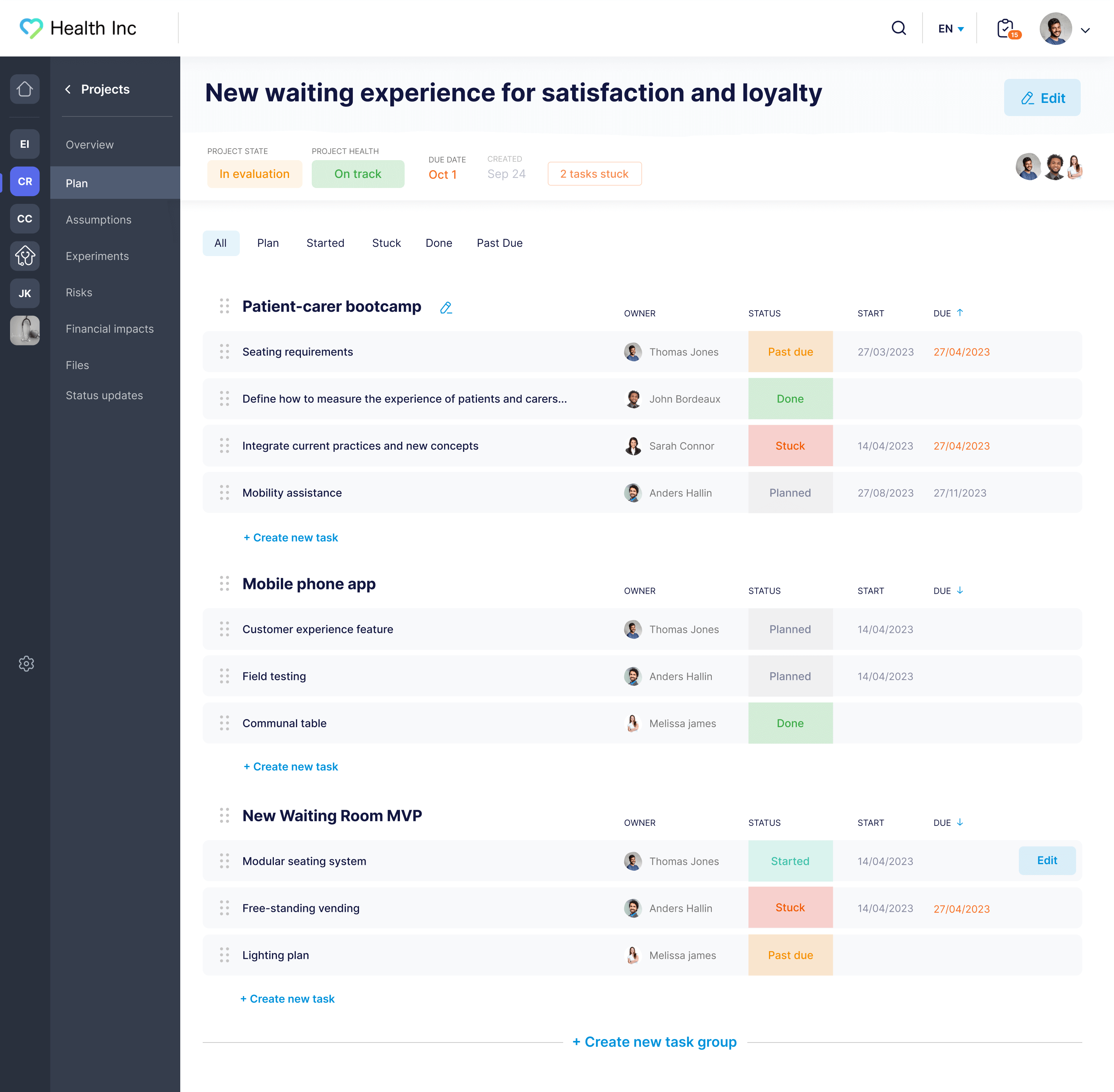
This keeps employees engaged since they know the company is doing something with their ideas. They aren’t sitting unused.
Employees can see whether their idea is in refinement, evaluation, prioritization, validation, or implementation. They are notified whenever something happens to their idea, including if it is chosen for experimentation and when their expertise is needed.
Step 3: Empower Employees to Propose and Test New Ideas
Idea crowdsourcing is a common way companies kick-start a culture of experimentation since it gives employees an outlet to share ideas for testing new things.
While we recommend that companies use crowdsourcing to collect ideas, as it enables them to access viewpoints from the broader workforce, the subtleties behind how you crowdsource ideas are essential to the success of your company culture.
Many companies create a call for ideas by sharing a web form, setting up an email address or messaging all employees with an invitation to get involved. They think this is enough to spark ideation and experimentation. There are a couple of problems with this approach:
Employees can’t see what happens to their ideas: As we mentioned above, a major threat to building a culture of experimentation is when employees feel their ideas are forgotten or ignored — leading them to stop submitting new ones. This feeling is amplified when ideas are funneled into a “black box” submission form or email address without visibility into what happens next.
Ideas are irrelevant to company priorities: A context-less web form or email address leaves employees with little information on the company’s focus areas. As a result, employees share ideas that are then marked as irrelevant, which the company rejects. Employees feel discouraged, and they stop sharing ideas.
The experimentation culture fades from employees’ focus: Launching a web page or company email address accepting ideas might generate buzz initially. However, employees gradually lose awareness as daily work demands take center stage.
We advise companies to be intentional in how they collect ideas. Instead of creating an open call for ideas, make a conscious effort to communicate the company's core goals to employees and restrict idea submission to those areas. Then, set firm deadlines for when ideas must be submitted, as this keeps innovation top of mind.
An effective way of doing this is through Innovation Challenges.
An Innovation Challenge is a formal invitation — shared as a digital document — that calls for creative solutions to a defined problem with a clear deadline for submissions. Employees can read the invitation content to better understand business goals and priorities and then submit ideas that align with them.
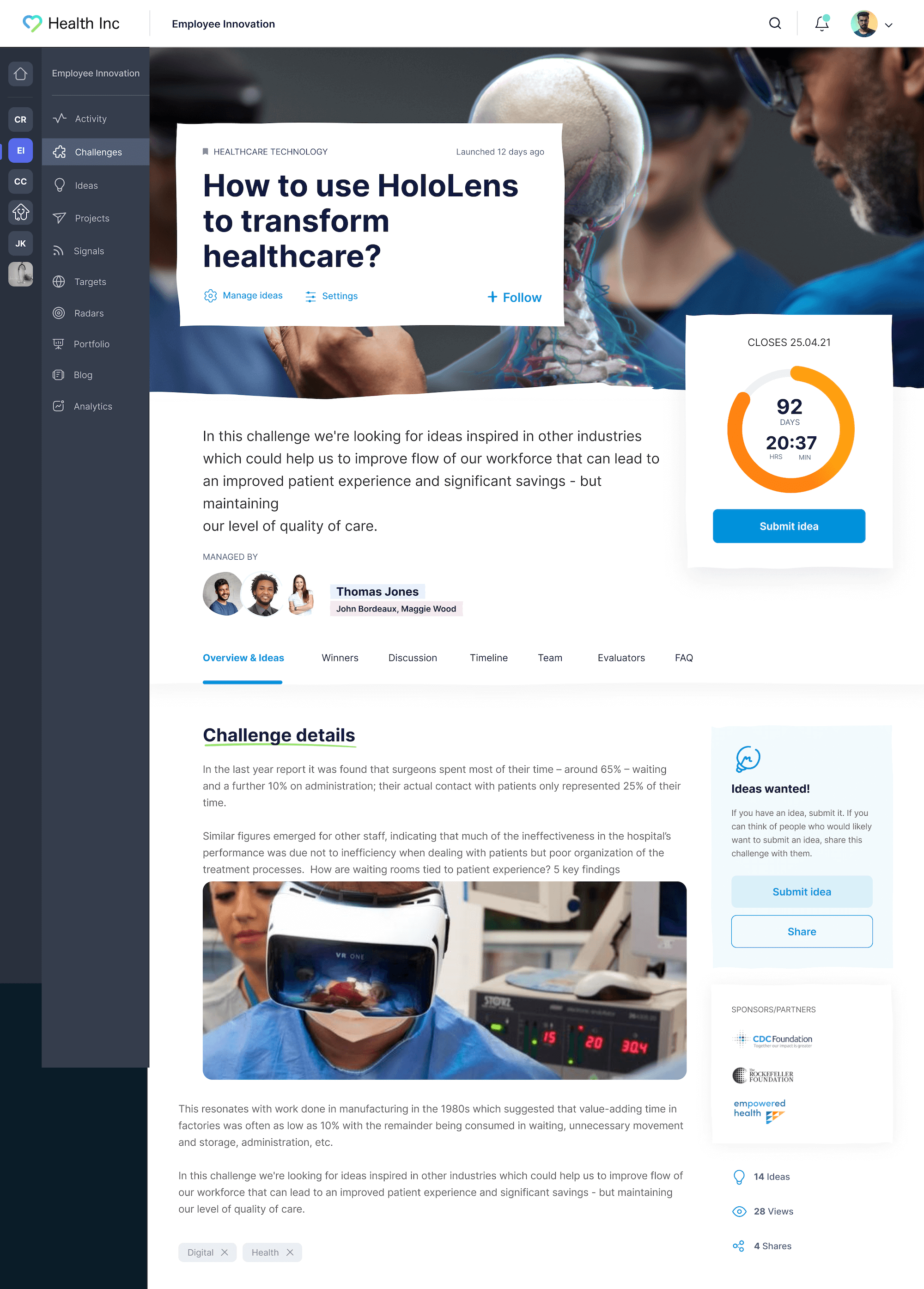
Companies Can Run High-Quality Challenges with InnovationCast
While it is possible for companies to create Innovation Challenges (with context and deadlines) using Google Docs and Google Forms, one key limitation remains unaddressed: employees cannot see what happens to their ideas because they are essentially submitting them into a black box. Over time, they think the company didn’t even bother reviewing them — and eventually stop sharing ideas.
As we alluded to above, this is where InnovationCast can help you shine.
Companies can create Innovation Challenges that contain context and deadlines, and InnovationCast calls employees to share their best ideas.
Employees can follow their idea’s journey with full transparency after submission. They know who’s evaluating it and how it stacks up against the judging criteria. If it is rejected, evaluators are required to provide feedback.
Additionally, if their idea is implemented, top management can choose to give them insight into the revenue or cost savings their idea is generating for the company. This boosts employee morale and maximizes the chances of them sharing ideas in the future.
InnovationCast helps you improve your innovation challenges by providing expert resources — like templates, examples, and case studies — that offer proven suggestions based on everything we’ve learned about creating effective challenges.
Read more: How to Implement an Effective Idea Generation Process in Your Organization
Step 4: Put Ideas Through a Refinement & Evaluation Step Before Validation
We propose placing ideas through a refinement and evaluation step before testing them:
Idea refinement: All employees should be able to review idea submissions and use their skills to improve them with the idea author or filter out flawed, poorly thought-out ideas.
Idea evaluation: Subject matter experts serving as evaluators should apply their domain knowledge to make reasoned judgments about the idea’s impact, feasibility, viability, scalability, etc., and score them in these areas.
This leaves companies with a shortlist of refined ideas ready for testing. They aren’t testing every idea an employee has.
That said, idea refinement is difficult for most companies because they use multiple ad hoc tools to assemble the innovation process. Different departments use different experimentation tools to manage ideas and results. There is no platform where employees from different departments can sign in, view ideas, and contribute their expertise.
InnovationCast Displays Ideas for the Entire Workforce to See
To address the siloed manner in which ideas are managed within most companies, we built InnovationCast with a focus on collaboration.
When employees reply to an Innovation Challenge posting, InnovationCast enables everyone else inside the company to view it on their activity feed.
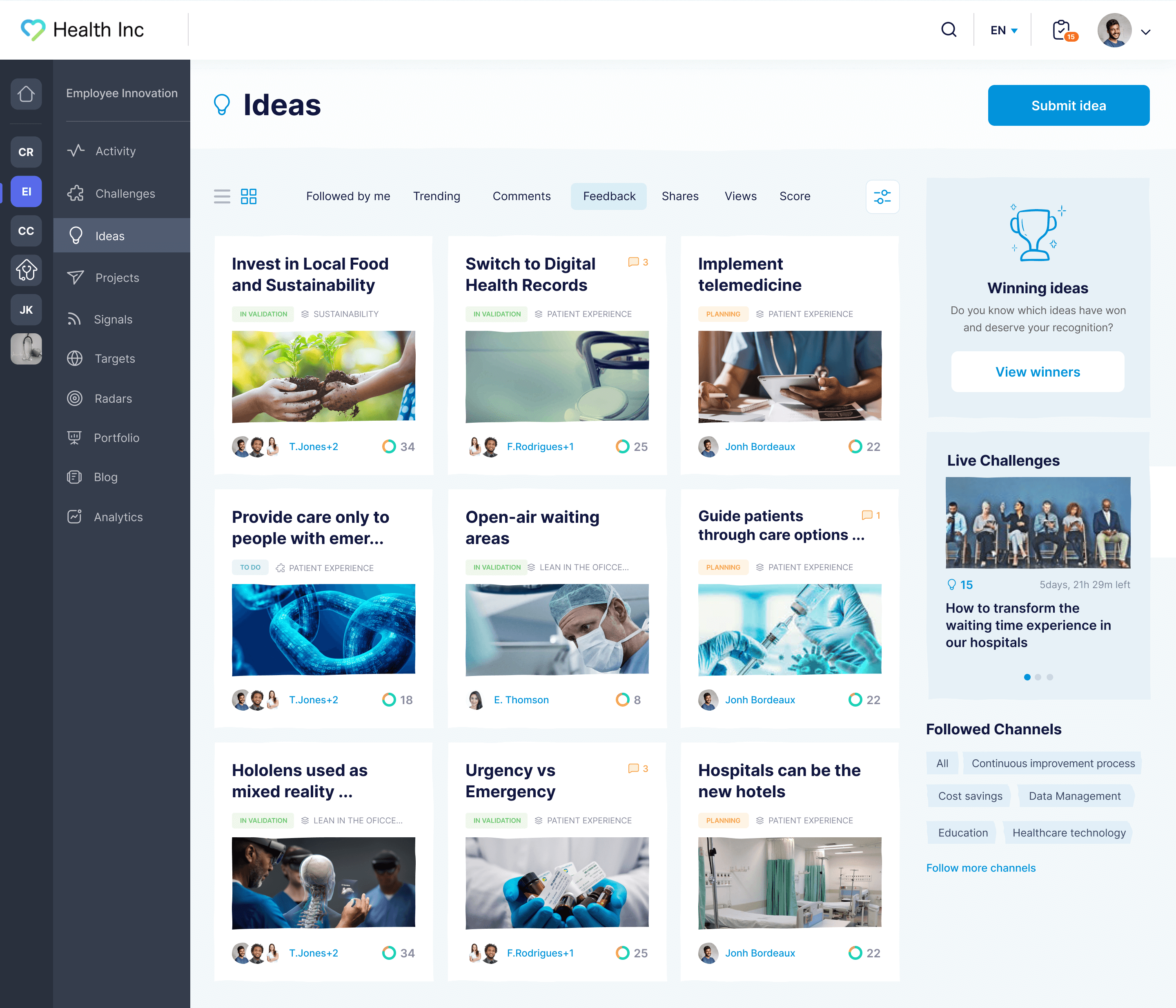
InnovationCast nudges employees in different departments to scan through the details, information, data, and evidence inside the idea. They can then vote on how good they believe the idea is and give the idea author feedback for improvement.
Innovation managers can invite domain experts to score ideas and decide which to move forward to experimentation and testing. This ensures that companies only dedicate resources to the best ideas.
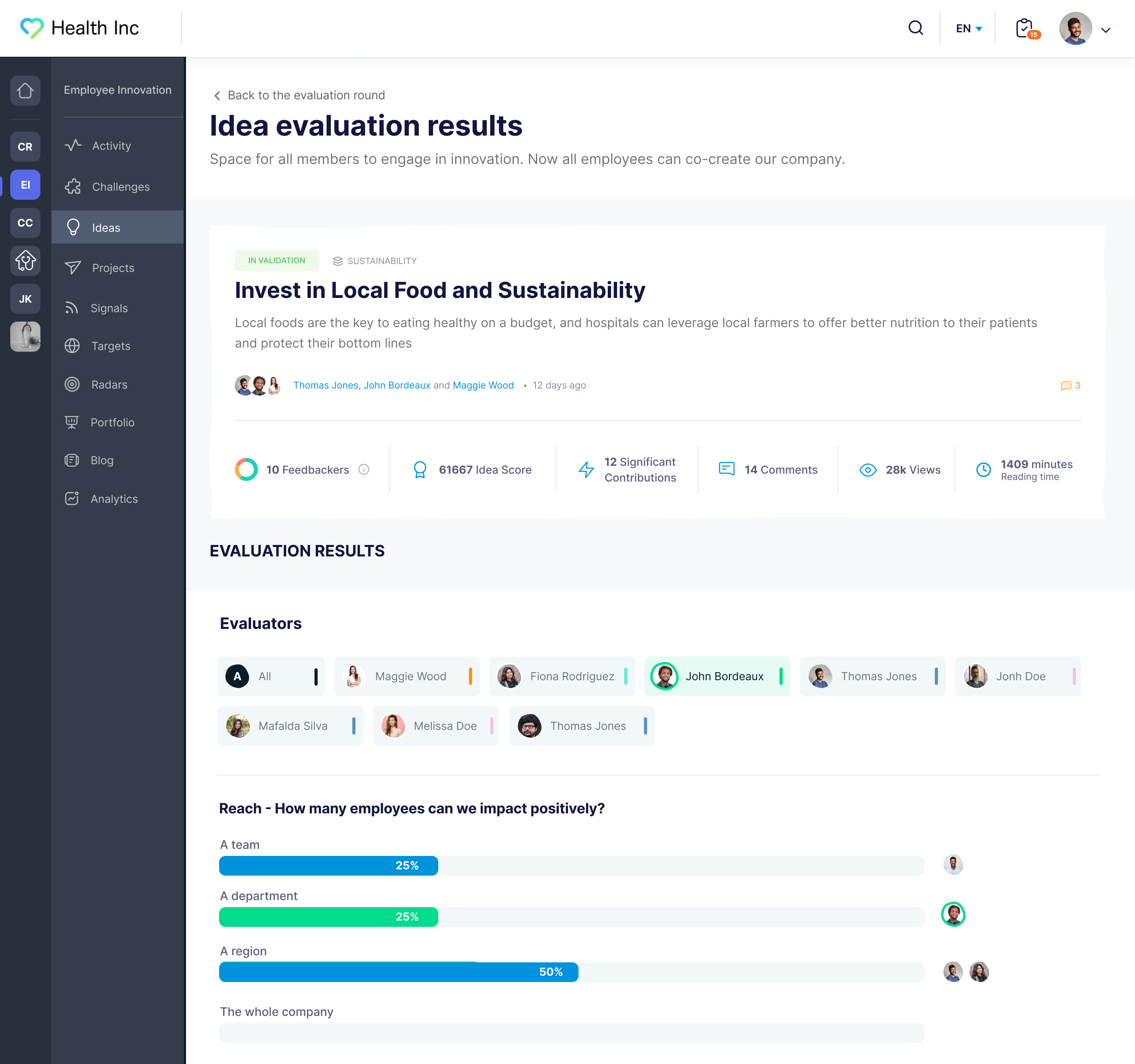
Step 5: Implement the Workflows, Tools & Processes to Test Ideas
After evaluation, top management creates a validation team and gives them a budget and schedule to validate key assumptions about an idea.
Most companies fail to establish cultures of experimentation and drive actual business growth because they neglect to set up the workflows, frameworks, and systems needed to assist teams in testing and validating ideas.
Workflows are fundamental to experimentation program’s success because employees aren’t innovation managers. They lack the knowledge of designing and running experiments, deciding which experiments to prioritize, evaluating results, and determining whether the data supports moving forward or shelving the idea.
Without proper guidance, team members often experiment with ideas haphazardly, which ends in unsuccessful outcomes.
The innovation department should create workflows for employees to follow when experimenting with ideas. Additionally, they should establish different workflows for testing different types of ideas. For instance, testing whether there’s demand for a new product idea will have different steps than improving an operational process.
Read more: Innovation Lifecycle: 7 Steps for Sourcing & Validating Ideas
InnovationCast Workflows Walk Teams Through the Process of Experimenting on Ideas
InnovationCast workflows are blueprints or roadmaps for testing different kinds of ideas and making data-driven decisions.
Our workflows show employees how to map assumptions correctly, the most effective way to test assumptions, which experiments to run, what KPIs to focus on, and how to pivot. This provides structure to the validation process and ensures employees know how to test ideas.
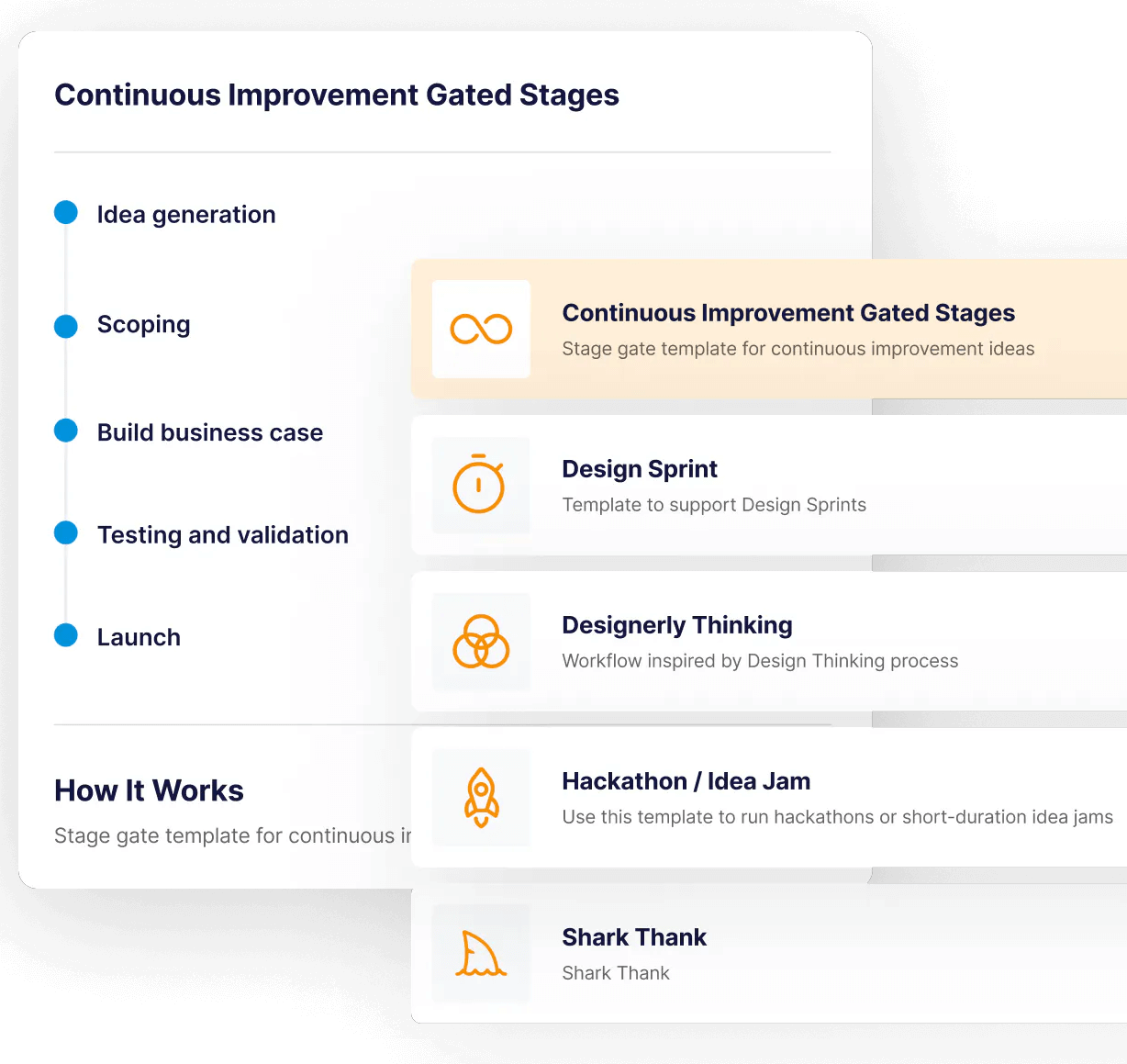
We carefully crafted these workflows based on what we learned over the last decade when managing validation projects. We also adopt select practices from Lean Startup, Jobs to be Done, Customer Discovery, and other innovation methodologies.
For example, if an employee is testing a new product idea, our workflow will look something like this:
Define the core assumptions: This product has enough demand to make it viable and profitable.
Design an experiment to test the assumption: Set up a simple landing page under a mock or test brand, present the product as if it were available for purchase, run targeted ads to drive traffic to the page, and measure how many people proceed to checkout before being redirected to join the waiting list.
Track KPIs: Validate the assumption by monitoring key metrics such as click-through and conversion rates, using these insights to inform decision-making.
Test the next assumption: Once the first assumption is tested and validated, we move on to the next assumption. This might relate to technical feasibility, usability, scalability, or regulatory compliance.
Innovation managers can assign each task within the workflow to a specific individual or team, and InnovationCast sends them a message when their input is needed. As ideas progress, the platform alerts the next responsible person.
Step 6: Document Your Learnings in a Centralized Platform for Stakeholders and Other Decision Makers to See
As teams optimize ideas and uncover knowledge about risk, feasibility, demand, and impact, it is essential to document their learnings on a centralized platform. This creates a transparent trail of knowledge that others can build on, helps avoid repeated mistakes, and accelerates organizational learning. Documenting and sharing learnings turns one team’s insight to everyone’s advantage.
Most importantly, proper documentation enables top management, innovation leaders, and stakeholders to see what experiments were run, what outcomes were achieved, what lessons were learned, and what return on investment was realized. This is key to maintaining funding for the experimentation culture initiative.
Unfortunately, most companies don’t have dedicated innovation software where all experiment results are stored. Different departments track results in different tools, making it difficult to gain insight into the success of experiments. The product team may document results in Microsoft Power BI while the marketing team uses Google Analytics.
Read more: How to Create a Collaborative Innovation Process and Network
InnovationCast Portfolio Management and Reporting Dashboard Feature
Innovation managers and top management can login to InnovationCast’s portfolio management feature and view all the experiments employees run alongside their results and knowledge gained. InnovationCast clients usually keep track of the following:
Financial impact metrics: Cost savings, revenue generated, return on investment.
Speed and efficiency metrics: Time to implementation, resources spent on each experiment, customer segmentation accuracy, and iteration speed.
Participation metrics: Number of ideas shared, idea quality, implementation success rate.
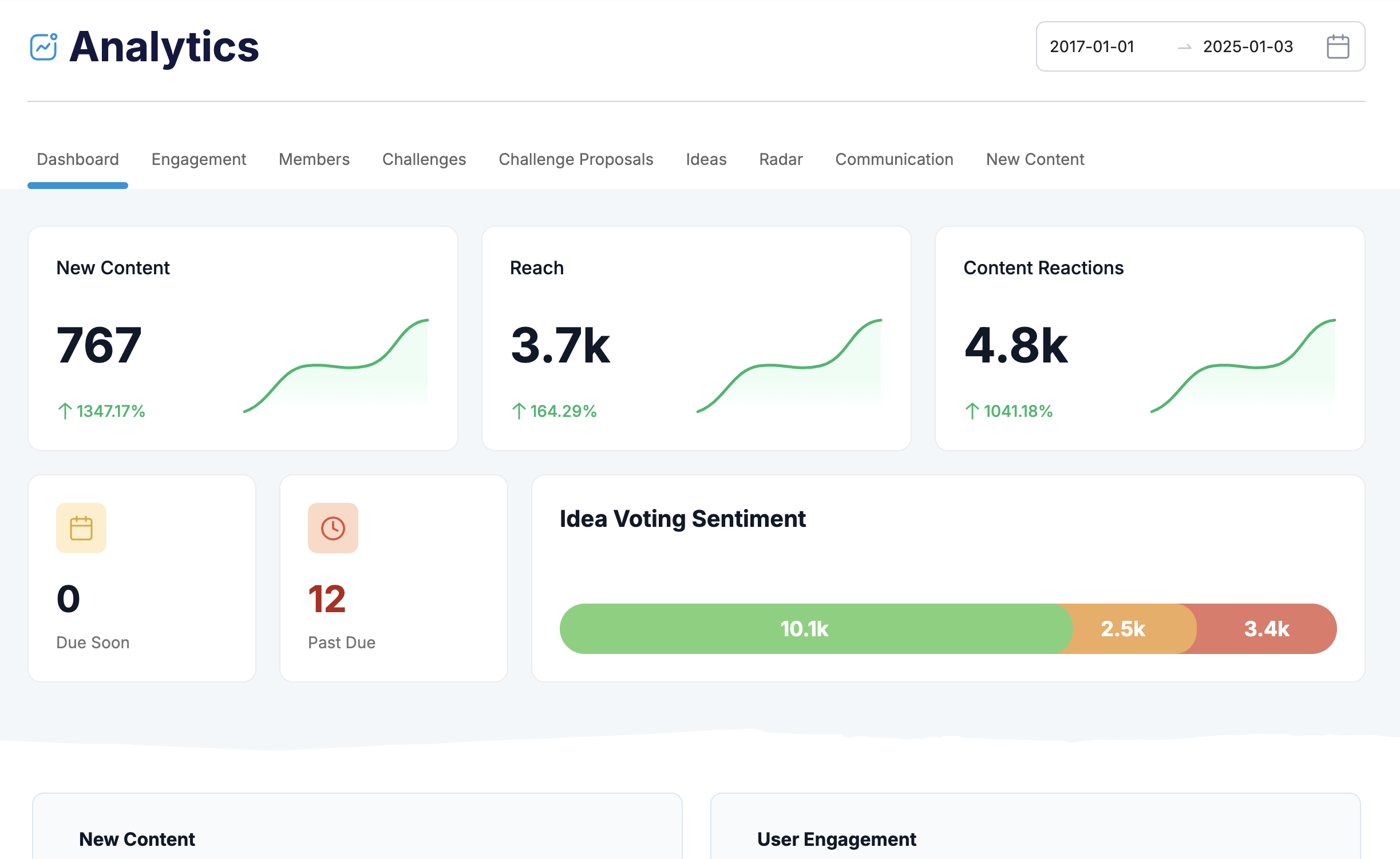
Top management can analyze the data and knowledge that support each idea and quickly decide which ideas are promising and deserve more funding and which need to be eliminated. This supports data-driven, smarter decisions and mitigates the risk of bad decisions impacting the customer experience.
Read more: How to Measure Innovation: Essential KPIs & Best Practices
Step 7: Reward Employees for High-Quality Experimentation
One of the most effective ways to spark employee engagement is to reward them for submitting, testing, and optimizing ideas. In fact, this is necessary because rapid experimentation requires employees to take time away from their day-to-day job responsibilities.
Companies can reward employees in several ways. The most popular rewards are financial rewards such as cash prizes, Amazon gift cards, PTO, movie tickets, etc. However, non-monetary rewards can work just as well. Many companies offer promotions, new roles, mentorships and coaching to employees.
The type of reward you use will depend on your company, but in our experience, all rewards work well. The most important advice we have on this topic is to reward employees based on the quality of their participation and not to give rewards for the sake of generic participation.
Rewarding quality participation motivates employees to research, brainstorm, and refine ideas, ensuring they’re developed to their fullest potential. Generic ideas aren’t enough to earn a reward — submissions must be thoughtful and actionable.
InnovationCast Badges and Rewards System
With InnovationCast’s automated badges and rewards system, innovation managers can establish what rewards employees will receive when they perform a specific action, such as submitting an idea, running experiments, or lending their input to evaluation efforts.
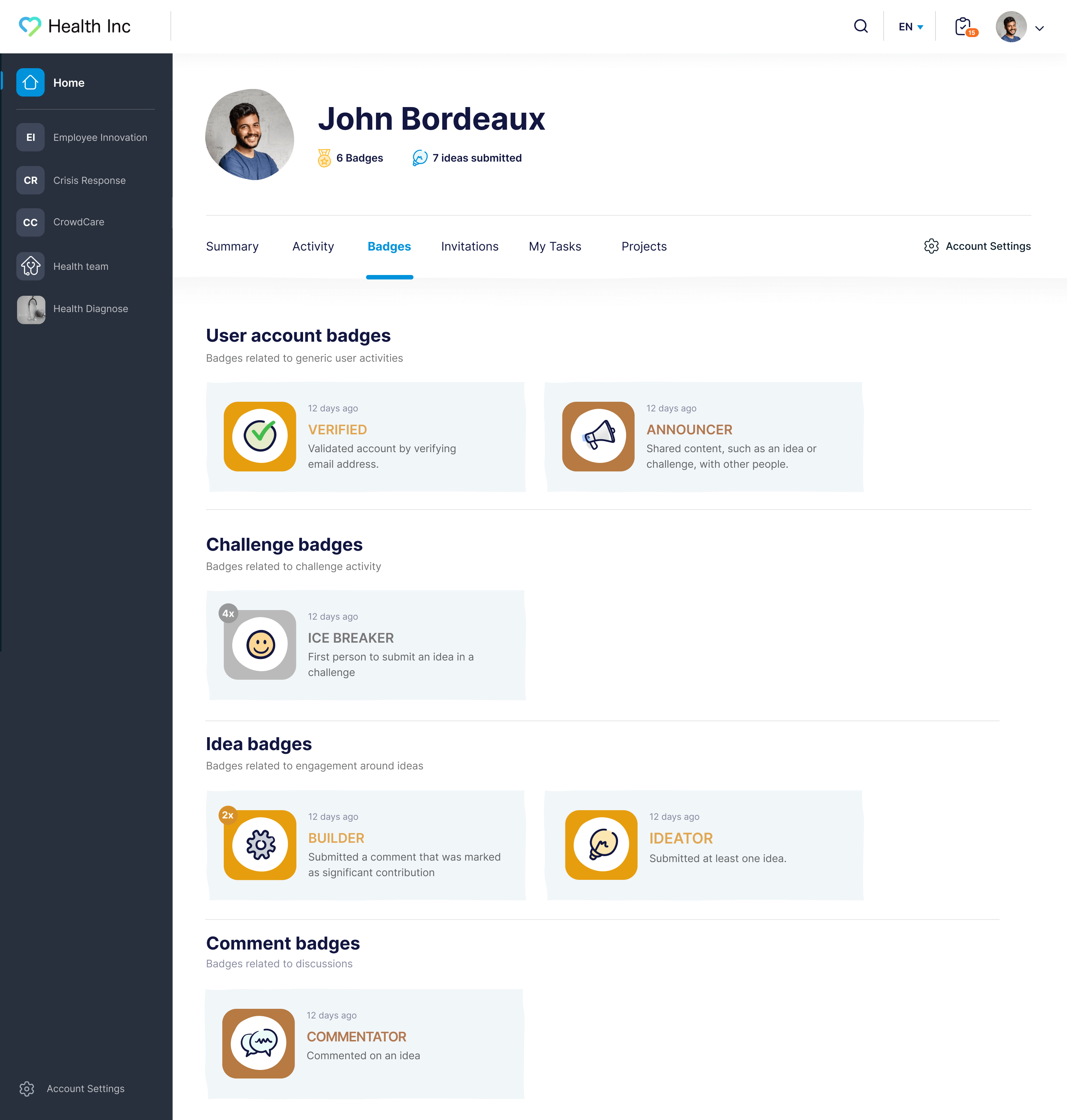
Unlike manually giving rewards, which can be time-consuming and inconsistent, InnovationCast’s automated badges and rewards system ensures that employees receive fair and predictable recognition for their contributions.
Culture of Experimentation Example: How InnovationCast Helped DHL Foster a Culture of Experimentation in Just 4 Weeks
DHL’s journey toward a culture of experimentation began with a common challenge: getting highly skilled IT professionals meaningfully involved in innovation.
With over 500,000 employees and billions of shipments handled each year, DHL already had innovation frameworks in place. But when it came to their 5,000+ IT specialists — who are critical to sustaining digital operations — sparking consistent engagement in experimentation was proving difficult.
To solve this, DHL partnered with InnovationCast to launch IdeaHub: a structured environment where experimentation became a part of everyday work. In just four weeks, the platform was operational — giving IT teams not just a space to submit ideas, but a clear path for testing, validating, and learning from them in real-time.
Within two years, idea contributions had grown by 67%. More importantly, the shift in mindset led to a 14% increase in implemented solutions, demonstrating the power of distributed innovation when experimentation becomes a shared responsibility.
Foster an Experimentation Culture with InnovationCast
Schedule a call with our team to see how we can foster a culture of experimentation within your organization.

